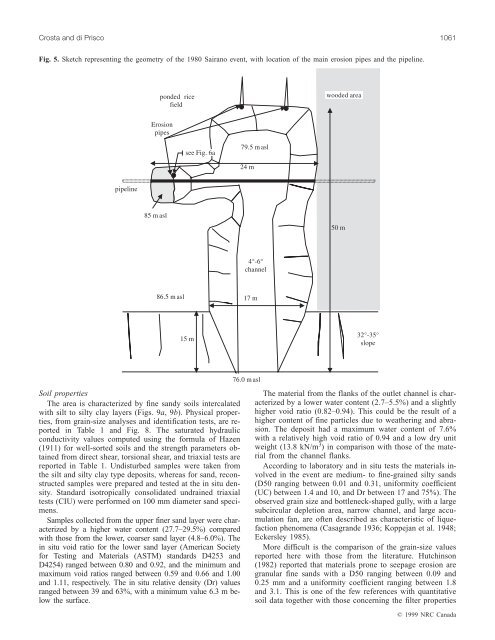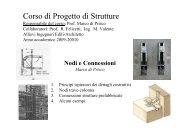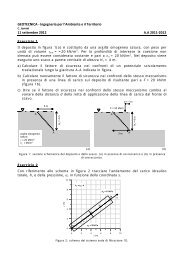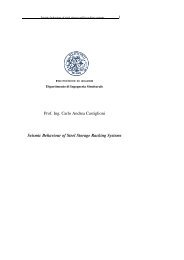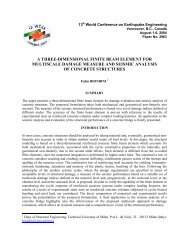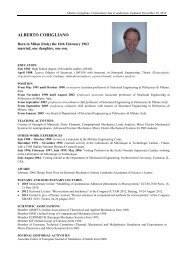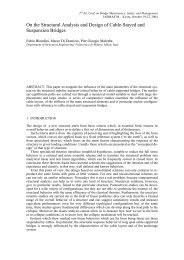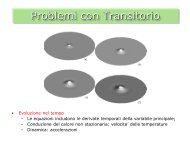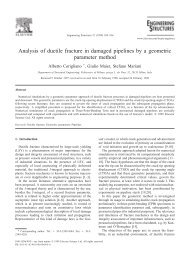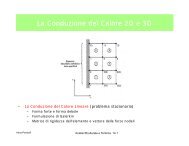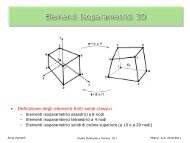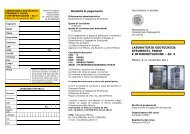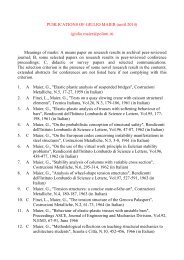On slope instability induced by seepage erosion - Ingegneria ...
On slope instability induced by seepage erosion - Ingegneria ...
On slope instability induced by seepage erosion - Ingegneria ...
Create successful ePaper yourself
Turn your PDF publications into a flip-book with our unique Google optimized e-Paper software.
Crosta and di Prisco 1061Fig. 5. Sketch representing the geometry of the 1980 Sairano event, with location of the main <strong>erosion</strong> pipes and the pipeline.Soil propertiesThe area is characterized <strong>by</strong> fine sandy soils intercalatedwith silt to silty clay layers (Figs. 9a, 9b). Physical properties,from grain-size analyses and identification tests, are reportedin Table 1 and Fig. 8. The saturated hydraulicconductivity values computed using the formula of Hazen(1911) for well-sorted soils and the strength parameters obtainedfrom direct shear, torsional shear, and triaxial tests arereported in Table 1. Undisturbed samples were taken fromthe silt and silty clay type deposits, whereas for sand, reconstructedsamples were prepared and tested at the in situ density.Standard isotropically consolidated undrained triaxialtests (CIU) were performed on 100 mm diameter sand specimens.Samples collected from the upper finer sand layer were characterized<strong>by</strong> a higher water content (27.7–29.5%) comparedwith those from the lower, coarser sand layer (4.8–6.0%). Thein situ void ratio for the lower sand layer (American Societyfor Testing and Materials (ASTM) standards D4253 andD4254) ranged between 0.80 and 0.92, and the minimum andmaximum void ratios ranged between 0.59 and 0.66 and 1.00and 1.11, respectively. The in situ relative density (Dr) valuesranged between 39 and 63%, with a minimum value 6.3 m belowthe surface.The material from the flanks of the outlet channel is characterized<strong>by</strong> a lower water content (2.7–5.5%) and a slightlyhigher void ratio (0.82–0.94). This could be the result of ahigher content of fine particles due to weathering and abrasion.The deposit had a maximum water content of 7.6%with a relatively high void ratio of 0.94 and a low dry unitweight (13.8 kN/m 3 ) in comparison with those of the materialfrom the channel flanks.According to laboratory and in situ tests the materials involvedin the event are medium- to fine-grained silty sands(D50 ranging between 0.01 and 0.31, uniformity coefficient(UC) between 1.4 and 10, and Dr between 17 and 75%). Theobserved grain size and bottleneck-shaped gully, with a largesubcircular depletion area, narrow channel, and large accumulationfan, are often described as characteristic of liquefactionphenomena (Casagrande 1936; Koppejan et al. 1948;Eckersley 1985).More difficult is the comparison of the grain-size valuesreported here with those from the literature. Hutchinson(1982) reported that materials prone to <strong>seepage</strong> <strong>erosion</strong> aregranular fine sands with a D50 ranging between 0.09 and0.25 mm and a uniformity coefficient ranging between 1.8and 3.1. This is one of the few references with quantitativesoil data together with those concerning the filter properties© 1999 NRC Canada


